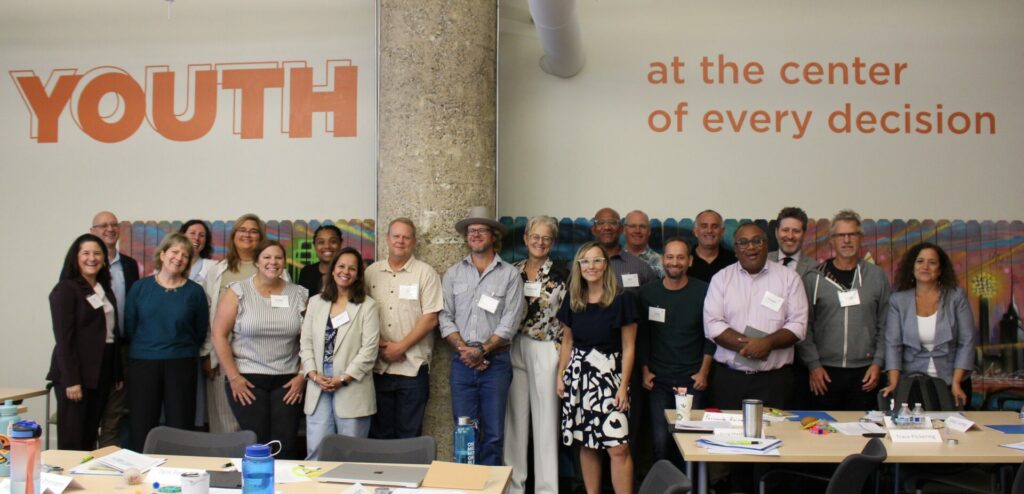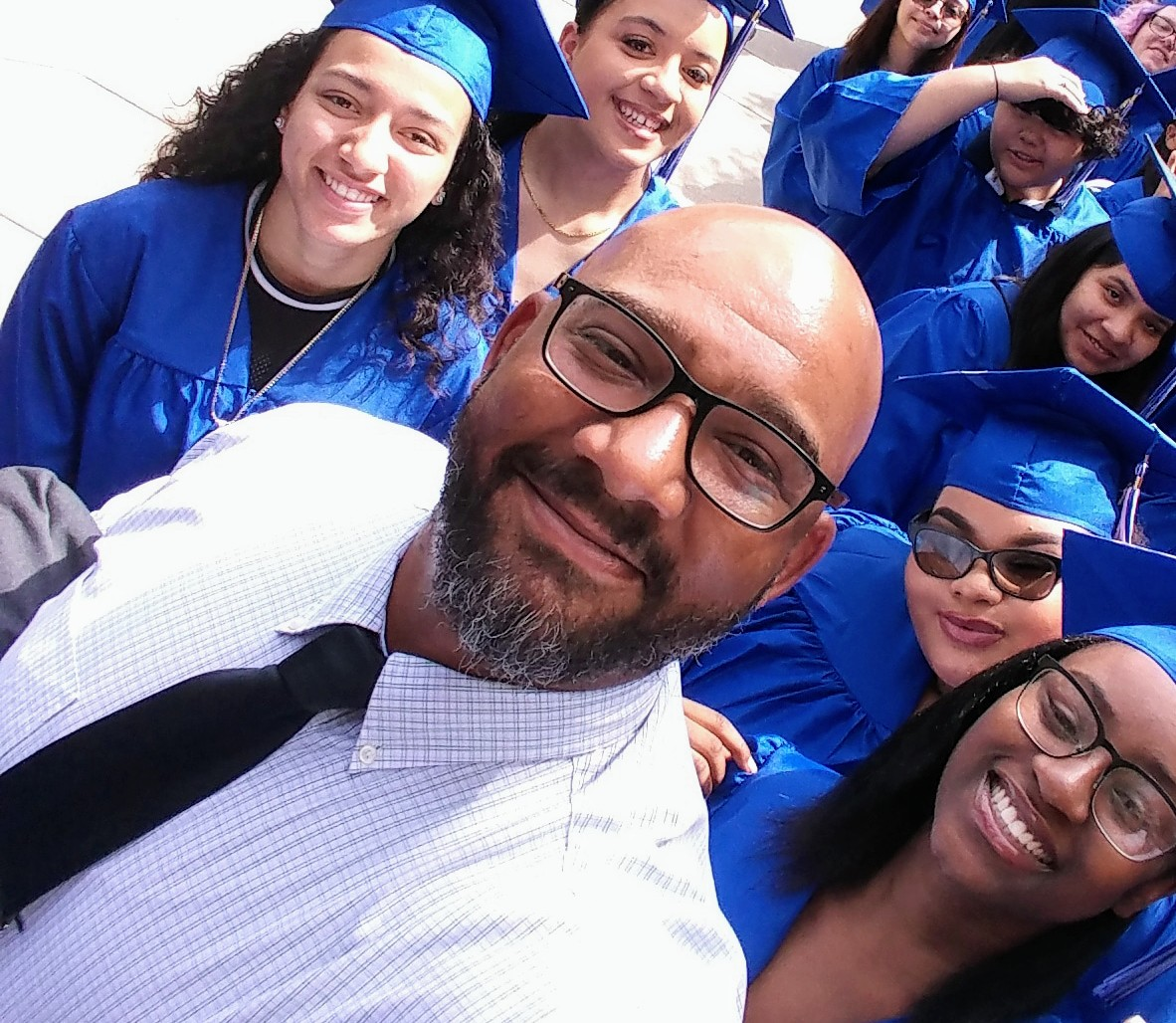We know each ecosystem will be unique and reflective of its own community’s context, but we also know that each community cannot be expected to reimagine and create new ways of organizing, supporting, credentialing, and resourcing learning all on their own.
Alin Bennett, Vice President of Practice and Field Advancement, Education Reimagined
As I walked into the Florence Gray Center in Newport, RI on a picturesque spring day in April of 2022, I was immediately struck by the atmosphere of community that was present. In one corner, I saw a community educator from the Norman Bird Sanctuary talking with Newport’s superintendent. I spotted four young learners playing HORSE at a hoop in the back of the gym. In another area, I could overhear a local pastor catching up with a family from his parish. Throughout the room, there was a buzz of excitement about what was going to happen throughout the day—a collective conversation on how they could make substantial change in their community through education.
This community gathering, organized by FABx, was fertile ground to explore how community-based, learner-centered education could transform the learning experiences of young people and families all over Newport County. In this meeting attended by folx from a wide range of sectors, a key inquiry was offered: What would it look like if we were to build a system of education that truly serves ALL learners and families?
As they engaged in stakeholder panels, visioning conversations, and design thinking exercises, new ways of constructing and organizing how our children learn in community began to show up. Within just a few hours, this Rhode Island community created a beautiful, transformative vision for how they want their young people, families, businesses, organizations, and community to experience education. I saw emerging from them all of the pieces of what we at Education Reimagined call a transformed learner-centered ecosystem, regardless of the terminology they used in the room. I left the gathering that day feeling personally moved by the power of their collective endeavor and re-energized with my own commitment to the catalyzation of community-based, learner-centered ecosystems.
At Education Reimagined, this is where I spend my time—partnering with the team and leaders in the field to explore and discover how we can catalyze, support, and sustain the invention of learner-centered ecosystems across our country. Over the last six months, I’ve helped to lead a cohort of incredible community leaders who share this commitment and who see how their own localities could become hosts for early ecosystem pilots. This cohort was brought together in the spirit of collective discovery. We know each ecosystem will be unique and reflective of its own community’s context, but we also know that each community cannot be expected to reimagine and create new ways of organizing, supporting, credentialing, and resourcing learning all on their own. There will be common opportunities, challenges, and resource needs across ecosystem inventors.
So, the premise of the cohort was relatively simple. If we are all exploring our next steps toward ecosystem invention, can’t we do it together? And from this process of building community, collectively questioning, and learning across differences, we’ve gained new insight and understanding of what this proposition of reinventing our public education systems to center our learners, prioritize equity, and embed community will take. I’m thrilled to share some of that learning today.
An Invitation to Dream, Explore, and Invent, Together
The development of this cohort began by identifying and engaging leaders from intentionally diverse communities and contexts, all eager to be in sustained, deep inquiry together. To strengthen this collective learning process, we were guided by a set of key principles in our search for aligned communities:
- The champions making up the cohort must be diverse, consisting of different identities and coming from different backgrounds—allowing us to gain insights from different perspectives and lived experiences.
- The learning environments represented must come from different entry points (e.g. districts, youth development, public charters, homeschooling) to explore the varied conditions in which ecosystem invention might happen.
- The geographic location of the environments represented must be as varied as possible—acknowledging that socioeconomic, cultural, and political realities will impact the trajectory of ecosystem development.
- The young learners served by the learning environments must be as diverse as possible—keeping us anchored in the context that learner-centered education is for ALL children.
- Where communities are in their journey of ecosystem development must be mixed—representing communities just starting out to ones that have been engaged for decades.
- The cohort must represent a variety of different “pieces” of an overall picture of ecosystem creation and growth—exploring the complexity of the systems and practices necessary for this to come to fruition.
After several months of outreach, conversations, and reflection, we had our cohort of nine diverse, powerful sites:
- Community Development Organization
- District-Level
- Homeschooling Cooperative
- National Educational Network or Affiliation
- Out of School Intermediary
- Public Charter
Now assembled, this group of committed inventors engaged in two interconnected strands of learning. The first strand was centered on learning, assessing, and deepening our understanding of this new, transformed system and how their local environments are expressing pieces of this system. The second strand challenged participants to plan bold, new actions based on the discoveries that were revealed throughout the first strand. They lived into these strands in a variety of ways:
- Creating a shared, distinct understanding and language for what is meant by learner-centered ecosystems.
- Partnering with important stakeholders from their community in deep visioning and listening exercises.
- Engaging with and providing insights on a collection of tools and resources that will accelerate learner-centered ecosystem invention.
- Participating in site visits to one another’s learning environments to gain a deeper understanding and appreciation of our work.
- Developing concept plans that describe the various systems, infrastructure, and/or practice solutions that they aspire to pilot in their communities.
Every community will begin at different entry points, whether from within current K–12 spaces, youth development intermediaries, early childhood programs, or workforce development initiatives.
Alin Bennett, Vice President of Practice and Field Advancement, Education Reimagined
Key Insights and Takeaways
By engaging with these dual strands of learning and action, this cohort has uncovered many insights. Some of these takeaways became apparent to us immediately, and others are more recent discoveries worthy of further reflection. For me, this emergence of learning has been exciting and compelling and is now informing work to come:
- While this work in communities requires a paradigm shift, that alone is not enough. People have been designing learner-centered sites and experiences for young people for decades. Yet, learner-centered education still operates at the edges of the field. It will take sustained commitment to the creation of new systems that the learner-centered worldview can authentically live into if we are to truly show the power of this way of organizing, supporting, credentialing, and resourcing learning.
- The creation of learner-centered ecosystems will require a full-time dedicated champion or group of champions embedded deeply in communities. Building a sustainable coalition committed to transformation will be paramount for every community, and ensuring there are dedicated individuals upholding the vision and stewarding its advancement at the start is just as important. Tasking learner-centered practitioners and systems-level players to invent, while also powerfully serving their communities is a massive request.
- This work will require a balance of urgency and intentional endurance. Learner-centered ecosystem pilots will have to build out the practices and infrastructure to powerfully support learners immediately, while simultaneously collecting the evidence to demonstrate the impact of this new system. This evidence will be required to make the case that this is a viable alternative to the current, dominant system of education. Even while doing this, communities will have to attend to the “long game”—maintaining both the entrepreneurial, experimental mindsets of second-horizon thinking and the visionary ones of the third horizon.
- Every community will begin at different entry points, whether from within current K–12 spaces, youth development intermediaries, early childhood programs, or workforce development initiatives. Each has their own opportunities. It is the leveraging of local and virtual assets to design a powerful learning journey that makes an ecosystem community-based, but that alone is not enough. People are already creating ecosystemic learning for their children, yet that does not necessarily mean it is learner-centered. Regardless of the entry point, it will be important to build strong home bases that can ensure learners are being served based on their unique strengths, needs, and aspirations. With every learner creating and navigating distinct learning journeys in an environment designed to nurture deep, consistent relationships, home bases are where communities can make existing ecosystem opportunities learner-centered.
- While the varied learning spaces will be imperative to each learner’s journey, it is the publicly funded and accessible infrastructure that will create the conditions for an ecosystem to be equitable. When you design systems, structures, and practices that serve the most marginalized communities well, you will inherently serve all communities. As we strive to gain clarity on how learner-centered ecosystems will be expressed in early developmental stages, it is paramount that ALL learners and families are centered. As Erynn Hughes writes, “True inclusivity means centering marginalized communities in the design process from inception to production.”
- We will know we are on the right path when this new system is fully distinguishable from the current, dominant system—when the systems, structures, and practices are unrecognizable from what the vast majority of children are currently experiencing. And, when we can confidently say that these learner-centered ecosystems, built in and with real communities, are reliably and equitably producing the kinds of outcomes and impact our society, economy, and democracy most needs and wants. That is our bar for success, and it is one worth striving for.
The work with this cohort has also left us with new questions. These give us an opportunity to dive deeper into the work and ensure that learner-centered ecosystems can and will serve all learners:
- If we see the role of the home base as paramount to the construct of the ecosystem, then we have to ask, “What will make the home base experience a transformative one for children, families, and other stakeholders?”
- As we are developing these ecosystems, how do we center and acknowledge those who have been and are marginalized? How can we be as inclusive as possible from design to operation?
- What practice and infrastructure solutions will allow for these systems to both saturate local communities and scale to others? How can we honor the unique transformation journey of every community without requiring each one to invent “from scratch”?
As one can imagine, pursuing deep, sustained work like this with a group of aligned and dedicated fellow travelers is powerful. Part of that power has been our ability to not only uncover a wealth of insights but also to continuously identify the questions that communities will have to grapple with to invent newly. I am excited to continue this work to widen our aperture, make new discoveries, and dive into the myriad questions—and opportunities for invention—that will continue to come up.
To learn more about this work, please visit The Big Idea. And to read about where learner-centered ecosystems could emerge nationally, check out Fertile Ground for Ecosystems, commissioned by the Carnegie Foundation for the Advancement of Teaching.

